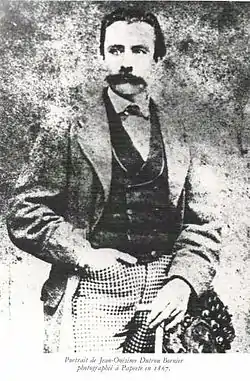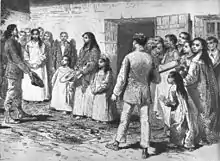Jean-Baptiste Dutrou-Bornier
Jean-Baptiste Onésime Dutrou-Bornier (19 November 1834 – 6 August 1876) was a French mariner who settled on Easter Island in 1868, purchased much of the island, removed many of the Rapa Nui people and turned the island into a sheep ranch.


Early life
Dutrou-Bornier served as an artillery officer in the Crimean War, and by 1860 had become a master mariner. He abandoned his wife and young son in France, and in 1865 bought a one-third share in the schooner Tampico. He sailed to Peru, where he was arrested, accused of arms-dealing and sentenced to death. Released on the intervention of the French consul, he sailed to Tahiti, where he began recruiting labour from the islands of East Polynesia for coconut plantations.[1]
Arrival on Easter Island
In November 1866 Dutrou-Bornier transported two missionaries, Kaspar Zumbohm and Theodore Escolan, to Easter Island. He visited the island again in March 1867 to recruit labourers, but he then amassed huge gambling debts and, as a result of some fraudulent deals, forfeited his share of the Tampico. He acquired the yacht Aora'i, and arrived on Easter Island in April 1868, where the yacht was burnt.
He set up residence at Mataveri, began buying up land from the Rapanui. In 1869 he seized Pua ‘Aku Renga, Koreto, the wife of a Rapanui, and married her. He tried to persuade France to make the island a protectorate, and recruited a faction of Rapanui whom he allowed to abandon their Christianity and revert to their previous faith. With rifles, a cannon, and hut burning, he and his supporters ran the island for several years as "governor", appointing Koreto Queen.[2] The title had no legitimacy behind it and is not recognized by the Rapanui or modern historians.[3]
Dutrou-Bornier aimed to cleanse the island of most of the Rapanui and turn the island into a sheep ranch. He bought up all of the island apart from the missionaries' area around Hanga Roa and moved a couple hundred Rapanui to Tahiti to work for his backers. In 1871 the missionaries, having fallen out with Dutrou-Bornier, evacuated all but 171 Rapanui to the Gambier islands.[4] Those who remained were mostly older men. Six years later, there were just 111 people living on Easter Island, and only 36 of them had any offspring.[5]

Death
In 1876 Dutrou-Bornier was killed in an argument over a dress, though his kidnapping of pubescent girls may also have motivated his killers.[6]
Legacy
From that point on and into the present day, the island's population slowly recovered. But with over 97% of the population dead or left in less than a decade, much of the island's cultural knowledge had been lost.
Neither his first wife back in France, who was heir under French law, nor his second wife on the island, who briefly installed their daughter Caroline as Queen, were to keep much from his estate. But to this day much of the island is a ranch controlled from off-island, and for more than a century real power on the island was usually exercised by resident non-Rapanui living at Mataveri. An unusual number of shipwrecks had left the island better supplied with wood than for many generations, whilst legal wrangles over his land deals were to complicate the island's history for decades to come.[7]
References
- Steven R Fischer The island at the end of the world. Reaktion Books 2005 ISBN 1-86189-282-9 p. 100
- Steven R Fischer The island at the end of the world. Reaktion Books 2005 ISBN 1-86189-282-9 pages 106-122
- Alfred Metraux (1937). "The Kings of Easter Island". Journal of the Polynesian Society. Polynesian Society. 46: 41–62.
- Katherine Routledge The mystery of Easter island page 208
- Collapse of island's demographics in the 1860s and 1870s
- Steven R Fischer The island at the end of the world. Reaktion Books 2005 ISBN 1-86189-282-9 page 120
- Steven R Fischer The island at the end of the world. Reaktion Books 2005 ISBN 1-86189-282-9 pages 106-122